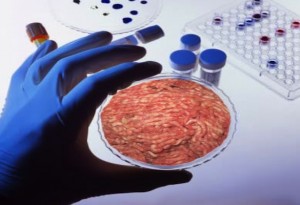Mar 21 2016
In Praise of Lab-Grown Meat
 Lab-grown meat now seems inevitable, although it is still hard to predict exactly how long it will take to become a popular consumer item. Here is a quick overview of what this is, and its potential to improve our food supply.
Lab-grown meat now seems inevitable, although it is still hard to predict exactly how long it will take to become a popular consumer item. Here is a quick overview of what this is, and its potential to improve our food supply.
Lab grown meat involves taking muscle stem cells from animals, like pigs, chickens, or cows, and then growing them, well, in a lab. They can be grown in a large vat of nutrients.
What you end up with is not fully formed muscle, as if it were taken from an animal, but simply a mass of muscle cells. Animal muscles also contain fat, vessels, and connective tissue, which help give it its texture. For taste the fat marbling is probably the most important.
We are not close to creating a full steak, but we can already create the equivalent of ground meat, for hamburgers, meatballs, meatloaf, or whatever you would use ground meat for. Last year a Dutch team claimed they were 5 years away from a marketable lab-grown meat product. The limitation is cost-effective mass production. They claim they can get the cost of a burger under $10 in that time.
That is still an expensive burger, but might be at a threshold for early consumer adoption. As mass production scales up, the cost will only go down.
Another industry that is likely to be an early adopter is pet food. Pets are likely to be less discriminating, and some animals really do need animal protein.
Why Bother?
Meat production is a problematic industry. For full disclosure, I do eat meat, but I recognize that the industry has some issues. I do not have an ethical problem with eating animals, as long as they are treated humanely during their life, including how they are slaughtered. I know this is a complex topic, and I don’t want to make it the focus of this article, so I will let that summary suffice.
There are also environmental issues. Growing meat for food is not very efficient. There are ways to maximize its efficiency, such as using land for grazing that is not suitable for crops. Even best case, however, consuming meat has a larger environmental footprint than consuming plants. For this reason I think it is reasonable to limit meat consumption, but I don’t think it has to be eliminated.
In any case, lab-grown meat solves some of these problems. There is no issue of the ethical treatment of animals. There is still an issue of where the nutrients come from to grow the cells, so the ultimate environmental impact will depend on this, but it seems we will have many more options for feeding cells in a vat than feeding live animals.
Interesting Possibilities
I am intrigued by the new possibilities raised by lab-grown meat. Once we get beyond the basics of creating tasty and properly textured meat, we can start exploring other possibilities, like genetically tweaking the stem cells to produce a healthier profile of fat.
It also seems likely that there will be gourmet varieties of lab-grown meat with special flavors and textures. Lab-grown meat may eventually surpass animal-derived meat in these qualities.
Another interesting possibility is deriving the muscle stem cells from wild or exotic animals. We will no longer be limited to the usual domesticated animals. If you want to try zebra, you can eat a lab-grown zebra burger (perhaps without the gamey flavor, which largely derives from what animals eat in the wild).
It might even be possible to derive muscle stem cells from extinct animals, like mammoth. You might be able to eat a mammoth burger one day (although a brontosaurus burger is sadly unlikely).
Conclusion
Lab grown meat is coming. It looks like we will see early commercial options in about five years. It probably won’t be long before the industry takes off after that.
The real advantages of lab-grown meat probably won’t manifest for a while, but then we will have the ability to explore many interesting possibilities. The luddites are sure to complain about genetically engineered artificial meat, but seriously, who cares. Let them complain while I enjoy my healthy, environmentally friendly, awesome tasting giraffe-loaf.






